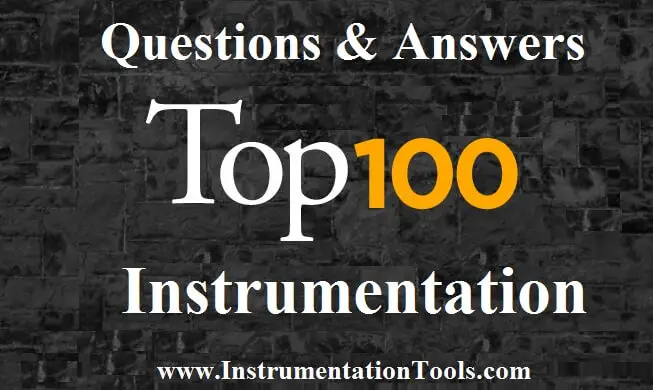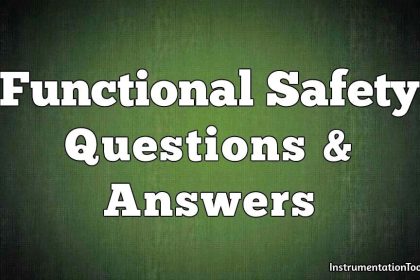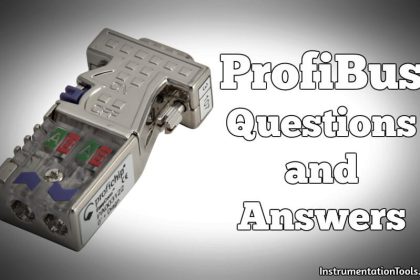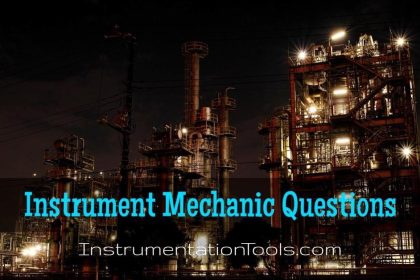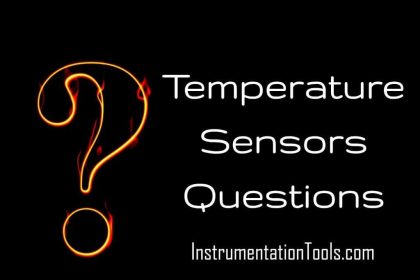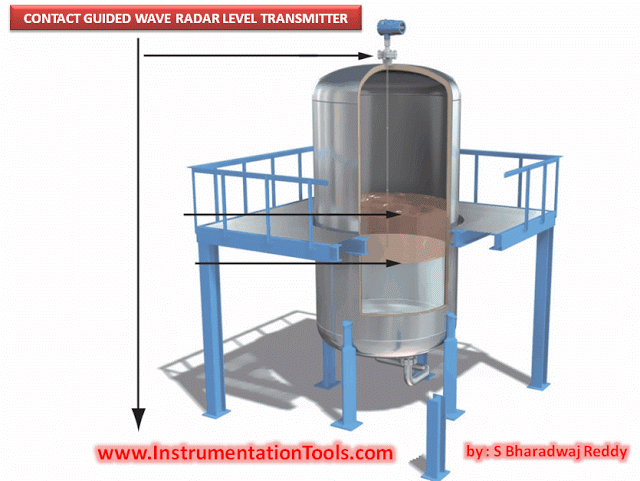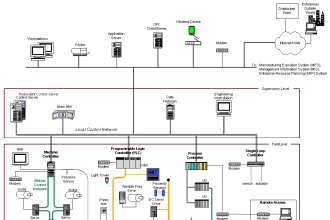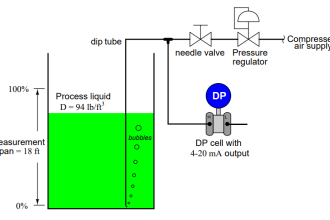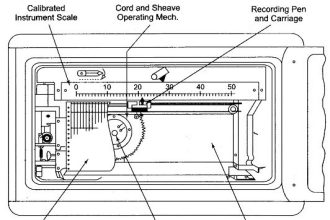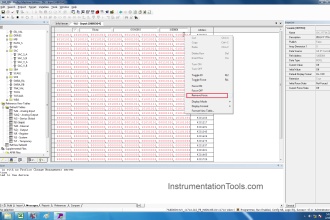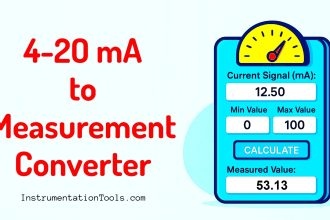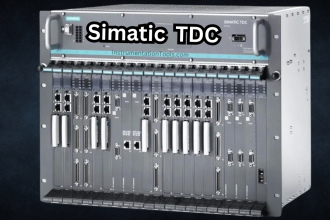Electronics and Instrumentation engineering interview questions and answers. Read the following 100 Instrumentation Basics Questions and answers useful for your interview preparation
100 Instrumentation Questions
Basic Questions
1) Define Viscosity.
It is a measure of fluidity of the system. Many fluids undergo continuous deformation with the application of shearing stress.
2) Define Newtonian fluids
If the force flow relation is linear then the fluid is Newtonian .
3) Define Non Newtonian fluids
If the force flow relation is non linear then the fluid is Newtonian .
4) Define Kinematic Viscosity.
Ratio of absolute viscosity to the density of the fluid.
5) Define Specific Viscosity.
Ratio of absolute viscosity of the fluid to the absolute viscosity of a standard fluid at the same temperature.
6) Define Relative Viscosity.
Ratio of absolute viscosity of the fluid at a given temperature to the absolute viscosity of a standard fluid at 20°c.
7) Define Viscosity index
It is an empirical number that indicates the effect of change of temperature on viscosity if a fluid.
8) Define fluidity.
It is the reciprocal of viscosity. It is unit is 1/ poise.
9) Define Humidity.
It is basically moisture content in air or it is the quantity of water vapour retained by gas.
10) Define Absolute Humidity.
Weight of water vapour in unit wait of gas. H=Wr / Wg
11) Define Specific Humidity.
It is weight of vapors in unit weight of mixture.
12) Define Relative Humidity.
This is the ratio of moisture content of gas to maximum moisture content of the gas at that temperature.
13) Define dew point.
This is the saturation temperature of the mixture at the corresponding vapour pressure.
14) Define various units of Humidity.
Vppm = parts per million / volume. G/ kg = weight concentration Relative humidity = in % Dew point in °C.
15) Define Hygrometer.
Used to measure the moisture content in air. It also used to measure humidity.
16) What is the basic principle of Hygrometer.
It consist of mechanical device measuring the dimension change of humidity sensitive materials like animal hair, animal membrane , paper etc.
17) Define Moisture.
Defined as the amount of water absorbed by solids or liquids.
18) What are the various methods of measurement of moisture.
- Based on the weight of the particle
- Based on the resistance, capacitance,
19) How will you find the % moisture present in the substances.
Mp = ( Wwet – Wdry ) / Wwet * 100
20) What are the different types of viscometer?
Say bolt viscometer Rotameter type Consistency meters.
21) What is Psychrometer?
Psychrometer is a device that uses the bulb thermometers to measure humidity. It is also used in air conditioning systems for maintaining humidity.
22) What are the different types of hygrometer?
- Hair hygrometers,
- Wire electrode hygrometers,
- Electrolysis type hygrometers,
- Resistive type,
- Capacitive type
- Microwave reflector
23) Explain the principle of saybolt viscometer.
As the viscosity of the fluid varies , the flow rate and hence time taken to drain the fluid through the capillary tube varies. The time indicates the viscosity and is denoted by say bolt number.
24) What is meant by consistency?
General term for viscosity and more often used in connection with Non-Newtonian fluids.
25) Explain the principle of oscillating type consistency meters.
When the inner cylinder is given an axial sinusoidal motion through a mechanical drive rod, the fluid in the annular space gets a shearing force and the motion in the inner cylinder well to transmitted the magnitude of this transmission will depend on the consistency of fluid.
26) What are the units of velocity?
- Feet per second (fsp)
- Feet per minute (fpm)
- Meters per second (mps)
27) Define Bernoulli equation.
In a given flow system, there is a relationship between pressure, fluid velocity, and elevation at any two points .
28) define Reynolds number.
Combination of density, viscosity of the fluid to a dimension describing length and the average fluid velocity.
29) Define rational expansion factor.
It is the ratio of compressible flow to the incompressible flow
30) What are the different types of orifice?
- Concentric orifice
- Eccentric Segmental
- Quadrant edge
31) define Concentric orifice?
It has a circular hole in the middle and is installed in the pipe line with the hole concentric to the pipe. Its thickness depends upon pipe line size.
32) define eccentric.
It is installed in with the bore tangential to the upper surface of the pipe, it is used where the liquid contains a relatively high % of dissolved gases.
33) define segmental
its hole diameter is 98% of pipe diameter. It is installed with a curved section of the opening coincident with the lower surface of the pipe.
34) define quadrant
edges is rounded to form a quarter circle. used for the flow of heavy crudes and slurry and viscous flows.
35) What are the advantages of using venturi tube as a restriction element?
- More suitable for slurry
- Accurate
- Calibrated easily
36) define pitot tube
It is an obstruction type primary element, used for fluid velocity measurement. Differential pressure across these taps is proportional to the velocity of the fluid.
37) What are the disadvantages of pitot tube?
They can become plugged with sediment and that the pressure difference sensed may not be large enough to give the desired accuracy for the flow rate under consideration.
38) What are the advantages of pitot tube?
- No pressure loss
- Economical
- Some types can be easily removed from the pipe.
39) define stagnation point.
Fluid approaching the object starts losing its velocity till directly in front of the body where the velocity is zero. This point is known as stagnation point.
40) define dall tube
It is an obstruction type primary element, used for fluid flow measurement. It produces large differential pressure with low pressure loss.
41) mention the advantages of dall tube.
- Slow head loss
- Short lying length
- Available numerous material of construction
42) mention the disadvantages of dall tube
- pressure difference is sensitive to up stream disturbances
- more straight pipe is required in the approach pipe line
43) what are sealing liquids commonly used?
Chloro naphthalene, dibutul phthalate, chlorinated oils.
44) what ae the different tapping of orifice?
- Flange tape
- Pipe tape
- Venacontracta tape
45) give the details about flange tape.
- Located one inch either side of orifice plate.
- Pressure difference is an integral part of the orifice.
46) give the details about pipe tape.
- Located pipe diameter from the orifice.
- Only the permanent pressure difference across the orifice is utilized.
47) give the details about vena contracta tape.
Down stream pressure tape is located variable distance from the orifice. Pressure difference is maximum for the given flow.
48) List the advantages of the orifice plate?
- used in wide range of pipe sizes
- used with pressure differential device.
- Available in many materials
49) List the disadvantages of the orifice?
- plate high permanent pressure loss
- reduces the use in slurry services
- accuracy depends on the care during installation.
- It has the square root characteristics.
50) What are the different types of positive displacement meters?
- Reciprocating piston type,
- Rotating vane type,
- Nutating disk type,
- Lobed impellar type,
- Oscillating piston type
51)List the advantages of reciprocating piston type
- high accuracy
- its construction material is not limited.
52) List the disadvantages of reciprocating piston
- type high cost
- subject to leakage
- problems created by dirty particle
- high maintenance cost
- restricted to moderate flow rates
53) What are the major three methods of flow meters?
- Area flow meter
- Mass flow meter & Quantity meters
54) What are the different types of thermal flow meters?
- Heat transfer flow meters
- Hot wire flow meters
55) Name the different types of weighing methods
- semiconductor feed belt weighing ( Batch weighing)
- continuous conveyor scale
- radio active transmission gauge
- volumetric solid methods
56) Write any two points of calibration of flow meter
- wet meter- manometer which is calibrated with mercury
- dry meter- manometer which is calibrated with mercury
57) Explain the principle of turbine flow meter
when the liquid enter through inlet, due to the inflow, shaft rotates which cuts the magnetic pickup, and produces the voltage which is proportional to inflow of water.
58) What are the different types of mass flow meter?
- Coriolis Mass Flow meter
- Angular momentum type
- Liquid bridge Calorimeter type
59) list the disadvantages of heat transfer flow meter
heat is directly placed in the fluid stream and easily damaged by corrosion large input power is required
60) List the advantages of turbine flow meter
- good accuracy
- excellent repeatability
- low pressure drop & easy to maintain
- good pressure & temperature range
- compensation of viscosity variation
61) List the disadvantages of turbine flow meter
- high cost
- limited use for slurry application
62) List the advantages of rotary vane type
- no pressure loss
- high temperature & pressure
- rating good accuracy
- available numerous construction material
63) List the disadvantages of rotary vane
- type high cost
- accuracy decreases in increase of flow
64) List the advantages of lobed impellor
- type increase accuracy at higher flow
- rate leakage is decreased
- can be used for corrosive
- solids good capacity range
65) List the disadvantages of lobed impellor type
cost high & require frequent maintenance
66) List the disadvantages of glass Rotameter subject to breakage
- It must mounted vertically
- It limited to low temperature
- Less accuracy
- If pressure is greater than 35 kg/cm3 tube get damage
67) list the advantage of oscillating piston type
- good accuracy
- can be easily applied to automatic liquid batching system
- good repeatability
- moderate cost
68) list the disadvantage of oscillating piston type
- available in small size
- suitable for clean fluids
69) what is the principle of densitometer
float density less than the fluid density, level increases float moves up, resistance connected float varies, so output varies. Voltage output is proportional to the density of the fluid.
70) list the advantages of nutating disk type.
- Less cost
- Good accuracy
- High temperature & pressure ratings
71) list the disadvantages of nutating disk type heavy
accuracy decreases in increase flow rate
72) what is Rotameter?
It is an example of variable area flow meter. When fluid enters lopped moves from the bottom to top. Distance is proportional to the flow rate.
73) Explain the principle of calorimeter flow meter
consist of two coil type resistance thermometer, difference of temperature between the thermometer is maintained constant.
74) List some example of inferential flow meter.
- Turbine flow meters
- Target flow meters
- Ultrasonic flow meters
75) Explain Faraday’s law .
whenever a conductor cuts the magnetic field, an emf induced is equal to the rate at which the magnetic lines of force changes.
76) list the advantages of electromagnetic flow meter?
- It can handle slurries & corrosive fluids
- It has low pressure drop
- It can be used as bi-directional meter Available in large pipe size & capacities
77) list the disadvantages of electromagnetic flow meter?
Expensive, Heavy and large size and Explosion
78) what are the different types of ultrasonic flow meters?
- Doppler flow meter
- Transit Time type meters
79) Explain the principle of vortex flow meter
it is based on vortex shedding which occurs when a gas or liquid flows around a non stream lined objects.
When fluid flows pass an obstacle, boundary layers of slow moving fluid are formed along the outer surface of the obstacle and the flow is unable to follow contours of the obstacle of its downstream side.
80) What are the different methods of solid flow measurement?
- Direct weighing system
- Pneumatic method
- Leakage flow technique
81) What are the advantages of solid flow measurement?
- It is used for flow measurement upto 100 tonees/ hr
- Accuracy is ±0.5 to ±0.75 of full scale deflection
82) What are the disadvantages of solid flow measurement?
For variation in size a correction factor is to be added.
83) list the applications of solid flow measurements
- used in chemical & fertilizer industry
- used in paper industry
- mining & associated industry for sand, rock, cement, lime etc food processing unit.
84) explain the principle of hot wire anemometer
It is used for unsteady flow of gasses. Because of constant voltage wire gets heated. Heat loss changes due to change in viscosity of fluid.
85) Write any guide lines for the selection of flow meters?
In order to cover reverse flow, pulsating flow, response time and so on
Extreme applications such as corrosive, non conductive liquid with large solid content the list will probably consist of a single meter.
86) explain the principle of leakage flow technique to find the solid flow rate measurement
electrode is used as the capacitance detector. When a material flows this leakage field changes and the capacitance increases. This increased capacitance detected at an interval depends on flow rate.
87) Rotameter is called variable area meter. Why?
The distance between the float and tapered glass varies. So area is also varying. So it named as variable area flow meter.
88) what are the advantages of using X- ray system?
It measures thickness with out contact with the material.
Well suited to measure thickness of sheet in rapid motion like rolling etc.
89) What are the uses of b-rays?
Used for thin metal sheets or foils, paper, rubber & plastics
90) What are the draw backs of using DC excitation in Electromagnetic flow meter?
- Used for materials of low conductivity & flowing at slow speed.
- DC amplifiers have many inherent problems
- Output is quite small.
91) What are the advantages of using AC excitation in Electromagnetic flow meter?
- High amplification
- can be more reliably ,cheaply and easily done.
- High speed and high conducitivty.
92) What is laminar flow?
Fluid particles move in a smooth fashion and tend to stray in layers. This layer like movement is called laminar flow.
93) What is turbulent flow?
Fluid velocity fast, particles also tends to have movement perpendicular to the over all the direction of flow, which is called turbulent flow.
94) define continuity equation.
It is the one of the most basic equation in flow calculations. It states that over all flow rate in the system is not changing with time.
95) What are the disadvantages of pitot tube?
They can become plugged with sediment and that the pressure difference sensed may not be large enough to give the desired accuracy for the flow rate under consideration.
96) What are the causes of pressure loss?
Due to friction, either with in the fluid or between fluid and boundaries. Fluid imparting (various fittings) on the objects.
97) List the direct level measuring methods.
- Float type level indicator
- Displacer type detector
- Sight glass type.
98) List the indirect level measuring methods.
99) What are the advantages of sight glass level instrument?
- Direct reading is possible.
- Special designs are available.
- Glass less devices are available in numerous material for corrosion resistance.
100) What are the advantages of displacer level instrument?
- High accuracy
- Reliable to clean liquids
- Mounted internally or externally
- Adaptable to liquid interface measurement.
